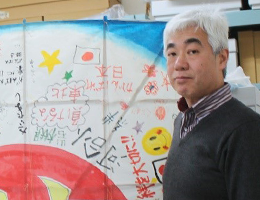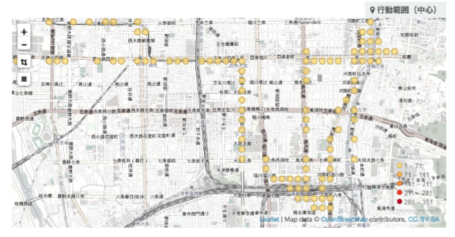他のメンバー : 呑海 沙織 綿抜 豊昭 宇陀 則彦 上保 秀夫 鈴木 伸崇 高久 雅生 BARYSHEV EDUARD 和氣 愛仁 江前 敏晴 松井 敏也
他機関 : 水嶋 英治 石田 栄美 Wertheimer, Andrew Gurrin, Cathal
キーワード:記憶資源、記憶情報、情報基盤、知識サイエンス、文理融合

記憶資源とは、個人や集団の記憶およびそれらが外在化した記録物や人工物も包含した概念で、記憶データと記録データを人や機械が利活用できるようにしたものです。地球規模の災害により人類が長年にわたり伝承してきた文化や思想が一瞬で失われている一方で、IoT機器の発達により個人の記憶データが爆発的に増大しており、人類の記憶と記録の保全は急務となっています。
従来内か外かで区別されてきた記憶と記録を資源化要件の軸に沿って連続的にとらえる記憶資源学の特徴に、エスノグラフィー、分類学、情報学、行動科学など分離融合型の多様なアプローチを融合させることで、記憶と記録の資源化を目指しています。
知覚・感情・組織化の連携で実現させる、記憶の記録化と資源化
本リサーチユニットは、「ライブラリ班」「ライフログ班」「震災アーカイブ班」の3つの分野で連携して研究を進めています。
1つ目の「ライブラリ班」は、メモや文書といった記録を一般の人が広く利用できるよう資源化・組織化する分野です。また、記憶の凝縮である書籍や雑誌などの媒体を見たときに喚起されるイメージとその記憶資源との関係性を解明する試みは、従来の図書館情報学において類を見ません。

図1:「お出かけ行動範囲」デジタルデバイスで得たデータから外出時の行動範囲を分析・視覚化したもの
2つ目の「ライフログ班」では、人の脳内にある記憶をデータとして読み解ける状態にまで引き上げて記録化しています。具体的には、高齢者に装着してもらったデジタルデバイスで日々の移動距離や天気などを測定し、得たデータを読み解いて高齢者の日々の振り返りに利用し、生きがいを感じてもらいます。この一連の作業により「記憶の記録化」の手法を編み出しています。
3つ目の「震災アーカイブ班」は、震災に関する記憶資源を集積し、「ライフログ班」による記憶の記録化と「ライブラリ班」の記録の資源化・組織化のノウハウを使って、震災に関する資料の資源化を目指しています。
図書館、文書館、博物館が連携する「Library Museum Archives(LMA)連携」は、文化資産の総合的な運用・活用方法としてかなり一般的になってきています。私たちは、知覚や記憶まで含めた資源化に挑戦しています。
デジタルアーカイブで最適化された、福島県双葉町の東日本大震災アーカイブ

図2:デジタルアーカイブ化された、国内外から双葉町に寄せられたメッセージ
「ライブラリ班」「ライフログ班」の知見を活かし、「震災アーカイブ班」が中心となって推し進めている事業の1つに「福島県双葉町の東日本大震災アーカイブス」があります。
本事業は、福島県双葉町の被災地・避難所で収集された、地域の人々やコミュニティの経験に関わる記憶や記録を保全するとともに、地域コミュニティの再生や今後の防災・減災対策の参考にするなど、資料の活用を進めるために立ち上げられました。
有形の記憶資源として千羽鶴や寄せ書きが保存されたほか、デジタルアーカイブには写真も保存されました。デジタルアーカイブに関しては、閲覧者が保存された写真にキーワードを付けるプロジェクトも行われています。
本リサーチユニットではこのように様々なケースに応じた記録の最適なかたちを提案し、時には地域の人々とともに記憶を資源化する取り組みにより記憶資源として再発見・再定義しています。またそれらの取り組み自体が、関わる人々の記憶を喚起させることそのものに資源としての価値があると考えています。
社会への貢献・実績
- ホームページ「福島県双葉町の東日本大震災関係資料を将来へ残す」公開(2013年)
- 高齢者向けアクティビティログアプリの開発・データ収集による高齢者の健康状態の向上
取材日:2020年2月14日
Preserving and Sharing Tangible and Intangible Memories and Records as Resources
Unit members : Donkai, Saori Watanuki, Toyoaki Uda, Norihiko Joho, Hideo Suzuki, Nobutaka Takaku, Masao Baryshev, Eduard WAKI, Toshihito Enomae, Toshiharu Matsui, Toshiya
Other agencies : Mizushima, Eiji Ishita, Emi Wertheimer, Andrew Gurrin, Cathal
Unit name: Memory resources
Key words: memory resource, memorized information, information infrastructure, knowledge science, interdisciplinary
 Memory resources are a concept that encompasses the memories of individuals and groups, as well as their externalized records and artifacts, and makes memory and recorded data available to humans and machines. While the cultures and ideas people have been handing down over many years are lost in an instant when a major global disaster occurs, the memory data of individuals are explosively increasing with the development of IoT devices. In such a situation, preserving human memories and records is an issue to be urgently addressed.
Memory resources are a concept that encompasses the memories of individuals and groups, as well as their externalized records and artifacts, and makes memory and recorded data available to humans and machines. While the cultures and ideas people have been handing down over many years are lost in an instant when a major global disaster occurs, the memory data of individuals are explosively increasing with the development of IoT devices. In such a situation, preserving human memories and records is an issue to be urgently addressed.
The Research Unit on Memory Resources aims to preserve and share memories and records as resources, adopting various integrative taxonomic approaches, including ethnography, taxonomy, information science, and behavioral science, based on the characteristics of memory resource science to continuously deal with memories and records, which have traditionally been distinguished as internal or external resources, along with resource preservation requirements.
Recording, preserving, sharing, and organizing memories, including senses and emotions, as resources
The research unit consists of 3 interactive groups: the <library group>, <lifelog group>, and <disaster archive group>.
First, the <library group> is in charge of preserving, sharing, and organizing records, such as memos and documents, as resources to be widely used by the general public. The attempts of this group to elucidate the relationship between images evoked by books, magazines, or other media as accumulated memories and memory resources are unprecedented in library and information scientific science.

Figure 1: Analysis and visualization of the range of activity when going out using data from digital devices
Second, the <lifelog group> converts memories in the human brain into readable data, and organizes them as records. For example, it attaches digital devices to elderly people to collect and analyze data, including the distance moved and weather, and utilize the results for the elderly to reflect on their activities daily and fulfill their lives. Through these processes, the group organizes “memories as records”.
And third, the <disaster archive group> collects disaster-related memory resources. It aims to preserve and share disaster-related documents using the <lifelog group>’s expertise to organize memories as records and that of the <library group> to preserve, share, and organize records as resources.
Library-museum-archive (LMA) collaboration is now taking root as a method to comprehensively manage and utilize cultural assets. We are trying to preserve and share even senses and memories as resources.
Optimizing Fukushima Prefecture Futaba Town’s archive materials related to the Great East Japan Earthquake as digital archives

Figure 2: Messages for Futaba Town from Japan and other countries preserved as digital archives
The preservation of Fukushima Prefecture Futaba Town’s archive materials related to the Great East Japan Earthquake as digital archives is one of the projects led by the <disaster archive group> using the <library group>’s and <lifelog group>’s expertise.
This project was launched to preserve personal and community-related memories and records collected from disaster-affected areas and shelters in Futaba Town, Fukushima Prefecture, while promoting the utilization of these materials for community restoration and future disaster preparedness/management measures.
In the project, Senbazuru (one thousand paper cranes) and a collection of messages were preserved as tangible memory resources. Photographs were also preserved as digital archives. As for digital archives, there is another project in progress, where viewers add keywords to preserved photographs.
Thus, we propose the optimal form of records for each case, and rediscover and redefine memories as memory resources through collaboration with community residents to preserve and share them as resources. We also believe that these efforts themselves are valuable as resources, because they stimulate the memories of the people involved.
Social contributions and achievements
- Opening of a website: <Preserving Futaba Town’s Archive Materials of the Great East Japan Earthquake for Future Generations> (2013)
- Development of an activity log application for the elderly and data collection to improve their health conditions
Interviewed on February 14, 2020
